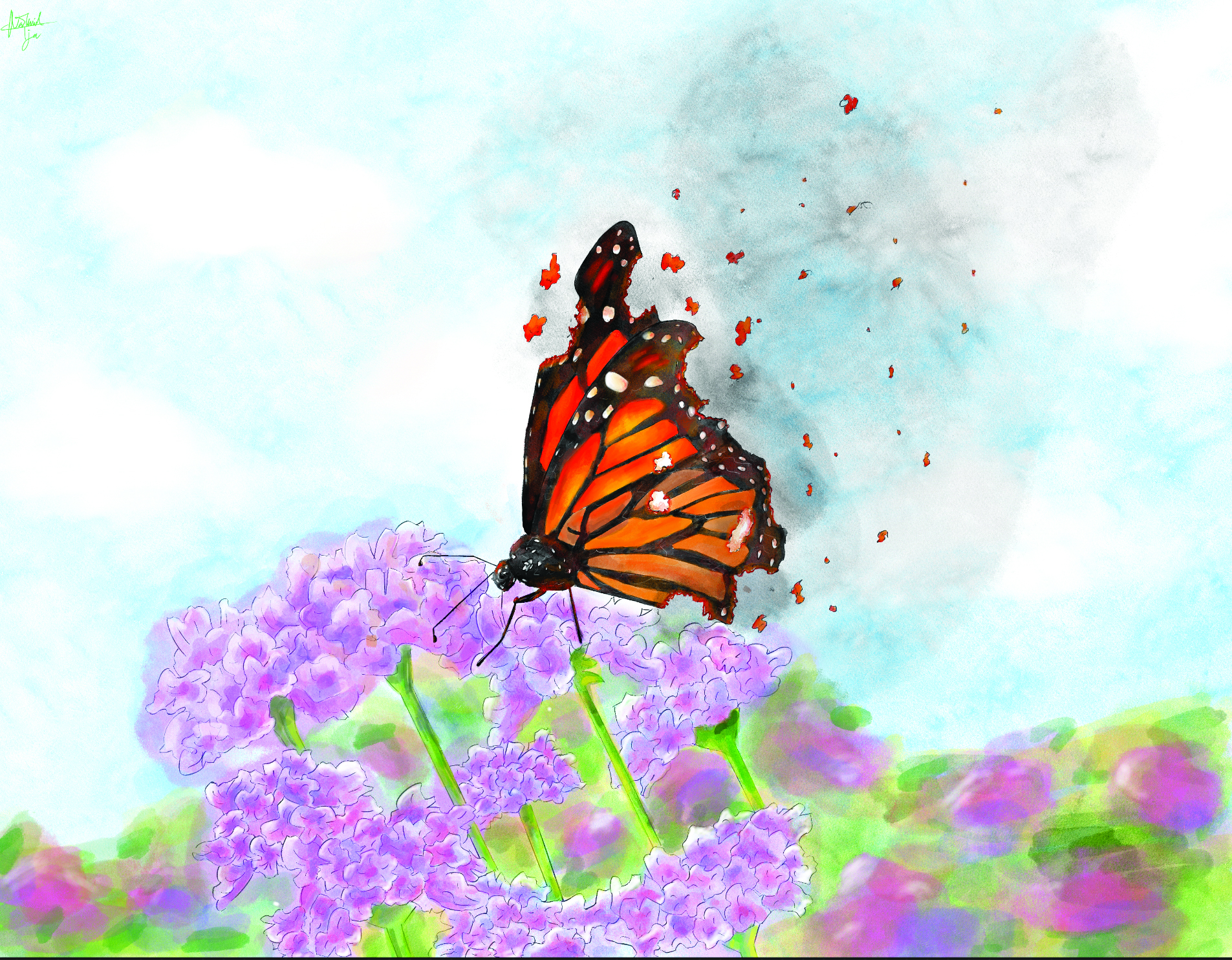As the sun shines on a summer day, the iconic black-and-orange banded wings of the monarch butterfly are nowhere to be found. As the seasons change, a heart-wrenching phenomenon is revealed: the silent demise of monarch butterflies. These butterflies are a part of a global “insect apocalypse”, the decline of thousands of insect species due to habitat destruction, pesticide use, and climate change. Notably, the western population of migratory monarch butterflies, which hibernates in California, has suffered a distressing 99.9% decline, going from 10 million butterflies in the 1980s to only 1,914 in 2021. As the fates of the butterflies, along with many other insects, lie in our hands, we must look to reverse our previous failures to address climate change.
Every year, monarch butterflies migrate over 2,500 miles from their summer breeding grounds in Canada and the US to overwintering (hibernation) sites in Central Mexico and along the coasts of California. The migration of monarch butterflies is not only beautiful but also plays a key environmental role in the process of pollination. As monarch butterflies migrate, they pollinate plants and disperse seeds that help ensure the reproduction of several plant species, such as lavender, lettuce, and celery. As the United States Forest Service puts it, “Without pollinators, the human race and all of earth’s terrestrial ecosystems would not survive.” But as monarch butterflies are increasingly threatened, we may soon have to figure out how to live without these pollinators.
In the village of Contepec, northwest of Mexico City, the winter days would bring in rivers of “orange and black butterflies” that would pollinate the flowers nearby. On a mountain called Sierra Chincua, just an hour and a half south of Contepec, hundreds of fir trees would be covered with monarch butterflies. Today, the winter monarch colonies are a poignant remnant of their former selves. The shrinking habitat size for winter monarch colonies, from an average of 22 acres in 1994 to a record-low of 2.9 acres in 2013, mirrors the significant decline in monarch butterfly populations. Illegal deforestation, fueled by demand for agricultural land, corporate ventures, and insufficient wood supply, is a major contributor to the habitat loss of winter monarch colonies. Illegal logging, often untracked and unreported, poses a significant challenge to addressing habitat loss. In addition, drug cartels are often involved in “narco-deforestation”, in which they illegally destroy forests to make space for drug-producing plantations, such as poppy plantations that produce heroin. Tragically, the killings of two butterfly activists that promoted reforestation efforts have highlighted the dangers in hindering cartel “narco-deforestation” activities. The locals are now hesitant to embrace reforestation efforts as they know that the cartels will “just get rid of people who get in their way.” Despite attempts such as the Monarch Butterfly Special Biosphere Reserve that seek to prevent all logging within its 217 square mile biosphere 100 northwest of Mexico City, illegal logging in Mexico is still widespread.
Furthermore, increasing temperatures from climate change threaten the monarch butterfly’s survival by decreasing the availability of milkweed, which is the sole source of food for monarch caterpillars. In addition, the increased use of pesticides, such as Glyphosate, leads to more harmful chemical absorption by milkweed, which is in turn absorbed by monarch butterflies. Glyphosate, a pesticide that is used by farmers to intentionally remove milkweed as it is an unwanted weed and harmful to livestock, both decimates milkweed and forces monarch butterflies to ingest neonicotinoids, chemicals that can inhibit their growth, impair their immune system, and prevent reproductive processes. To top it all off, monarch butterflies are not even considered “endangered” in the United States, as it has been determined that there are “higher priority species in need of conservation.” As a result, monarch butterflies do not get the same national resources or attention that are needed to avoid extinction.
For most of the monarch butterfly’s two million years on Earth, their migration into overwintering sites has been unimpeded. Yet, despite their long reign, it took just two decades for the monarch butterfly population to reach a point where, without serious change, extinction is inevitable. Although HSMSE students are unlikely to be involved in deforestation or hunting, we should still be ever-conscious of our actions as they have disastrous consequences. As individuals, the amount of littering and recycling we do is rather insignificant. However, put on a larger scale, our actions contribute to the IUCN Red List’s 16,306 endangered species and the United Nations’ estimated 1 million endangered species. Littering, even in small amounts, contributes to the annual world total of 2.12 billion tons that kills an estimated 1 million animals. The less we, as a collective species, litter and the more we recycle, the greater the chance that the biodiversity of the Earth prevails. However, it goes beyond recycling, the Earth is our home, and you wouldn’t want anyone destroying your home.
- Want to spend some time with butterflies this summer? Visit the Davis Family Butterfly Vivarium, now open at the Natural History Museum which is home to over 1,000 butterflies and 80 different species!

